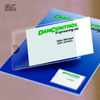- The EZ™ Viscosity Cups are produced to very close mechanical tolerance in elaborate jigs and fixtures, ensuring that each cup is correctly produced and are identical
- All parts of the flow cup are of stainless steel except for the name plate
- The formula for each cup of the series matches the applicable ASTM formula in D4212 at the recommended calibration level with 3% guaranteed tolerance that complies with & exceeds ASTM D4212
- Compatible to ASTM D1084 Viscosity of Adhesives and ASTM D816
- Calibration is traceable to the National Institute of Standards and Technology (NIST)
- Calibration and Certification procedures qualify under ISO/IEC 17025 as applicable
- Conversion table relating efflux time in seconds, to the nearest tenth of a second, to viscosity in centistokes included
- Orifices are machined rather than drilled to insure exact centering in the cup hemisphere base and a minimum of burr formation, insuring an orifice of specified length and a correct symmetrical efflux stream
- The support rods are offset from the side of the cup and secured to the cup sidewall below the cup rim, eliminating errors due to test material drainage from support surfaces
- The increased separation width of the support rods by over 20% and the lowering of weld to the cup provide best possible conditions for cleaning
- Viscosity Cups are non-returnable items and subject to final sale
Technical Attributes
| Cup Number |
Seconds Range |
Centistoke Range |
Midrange Sensitivity¹ |
Calibration Oil Number² |
| 1 |
40 to 60 |
10 to 36 |
1.3 |
G-10/19 |
| 2 |
20 to 60 |
19 to 156 |
3.3 |
G-60/117 |
| 3 |
12 to 60 |
64 to 596 |
10.5 |
G-200/458 |
| 4 |
10 to 60 |
79 to 784 |
13.9 |
G-200/458 |
| 5 |
10 to 60 |
161 to 1401 |
24.2 |
G-350/878 |
¹ Stated as centistokes per second of efflux time.
² Centistoke values are nominal - actual values printed on labels |
Standards
- ASTM D816
- ASTM D1084
- ASTM D4212
Procedure
- Select the proper number cup to be used from the Specification Table, which is dependent on the expected viscosity range of the material to be measured.
- Insure that the cup is clean and that there is no residual dried material in or around the orifice.
- Adjust the temperature, if necessary, of the test material.
- Completely immerse the cup into the material to be measured in a location free from bubbles or foam, holding the cup vertically by means of the stainless steel split key ring.
- Measure and record the temperature of the material that is encompassed by the cup.
- Hold cup vertically by inserting index finger into handle ring. In a quick, steady motion, lift the cup out of the sample material, starting the timer when the top edge of the cup breaks the surface. During the flow time, hold the cup no more than 6” above the level of the sample material.
- Stop the timer when the first definite break in the stream at the base of the cup is observed.
- Record the number of seconds of efflux time, temperature and the cup number. (Example: No. 2 EZ™ Dip Cup, 48.1 seconds at 25.1°C.) As an option to the preceding step, refer to the Insta Visc viscosity calculator Insta Visc App or conversion table for the cup to determine the centistoke viscosity for the measured efflux time in seconds and record this value and the measured temperature.
- Promptly clean the cup unless it will be used immediately for a rerun of the same material. (Use a length of nylon fishing line to clean the orifice.)
Viscosity Oils
- The G (Gardner) Series Viscosity Oils are certified viscosity reference standards used for the calibration Gardco Viscosity Cups, viscometers and rheometers. They facilitate accurate measuring for a variety of procedures associated with determining a fluid's resistance to flow.
- All oils come certified and traceable to NIST this document is the Certificate of Analysis, the Long Form certificate is an “Additional document” that supplements the traceability information that is described on the Certificate of Analysis.
- Oils with Long Form Certification include data points
- All Cannon Viscosity Oils are packaged in sealed, dark glass bottles. Net content of each bottle is 0.47 Liter (1 Pint)
- A label on each bottle gives the Viscosity Oil Name, Lot No., Termination Date, Viscosity in Centistokes at 25.00C (77.00F)* and a statement that the standard "is prepared expressly for Paul N. Gardner Co." by the Cannon Instrument Company and that data on the standard is traceable to the National Institute of Standards and Technology (NIST). *With the exception of the Parlin Cups whose Viscosity in Centistokes is measured at 23C in accordance with ASTM specification.
- A Material Safety Data Sheet (M.S.D.S.) accompanies each bottle of viscosity oil
- These viscosity oils prepared expressly by the Cannon Instrument Company for the Paul N. Gardner Company are produced in accordance with: ISO/IEC 17025, ISO 17025 and Guide 34 and ISO 9001. Viscosities for all standards sold by CANNON are based on the National Institute of Standards and Technology (NIST) value of 1.0016 mPa•s (centipoise) for water at 20°C (68°F).
- CANNON has been granted ISO 9002 registration for the manufacture and certification of viscosity standards.
- They are accurate to within 0.25% of the label value at specified temperature. This is a much closer tolerance than viscosity measuring devices normally available to users of viscosity cups. Therefore, there is no easy means of checking the viscosity to ensure that it remains at the value listed on the label except through very careful use of the standard to ensure its integrity. Included in this care should be making sure that any container used to receive the viscosity oil, as well as the cup to be checked, the thermometer and any other stirring device, be absolutely free of contaminants.
- Immediately following use, the standard should be returned to its labeled container and capped. If there is valid reason to question the original value of the viscosity standard, it should be replaced.
- The viscosity oils are used by the producer of Gardco viscosity cups not only to calibrate the cups but also to certify such calibration under ANSI/NCSL Z540 or ISO/IEC 17025, ISO 9001, as applicable, and in conformance with ISO 9000, which is available as an extra cost of service. One of the requirements under such certification is the replacement of the viscosity standard on or before the termination date. Experience has shown, however, that in the absence of contamination, the standards do not materially deteriorate over an extended period of time.
- CAUTION: Silicone fluids should not be used to calibrate viscosity cups. These materials change the interface between the cup surface and the test material and therefore change the cup calibration. The following is taken from ASTM D445; Viscometers used for silicone fluids should be reserved for the exclusive use of such fluids. Solvent washings from these viscometers should not be used for cleaning other viscometers.
If the certificate is ordered after the fact the manufacturer needs the cup back, AND customer is responsible for freight both ways.
Click to Download EZ Quick Guide
Click to Download Viscosity Cup Equivalent Wall Chart
Click to Download EZ/Zahn Dip Viscosity Cup Instruction Manual
- Models: MIS-13784, MIS-13786, MIS-13789, MIS-13791, MIS-13793, MIS-13785, MIS-13787, MIS-13790, MIS-13792, MIS-13794, MIS-13640, MIS-13641, MIS-13646, MIS-13647, MIS-13651, MIS-13652, MIS-13653 & MIS-13654
















